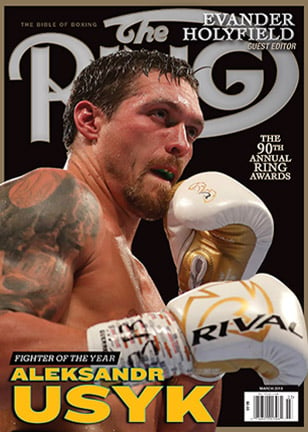The Travelin’ Man goes to Gervonta Davis vs. Hugo Ruiz: Part Two
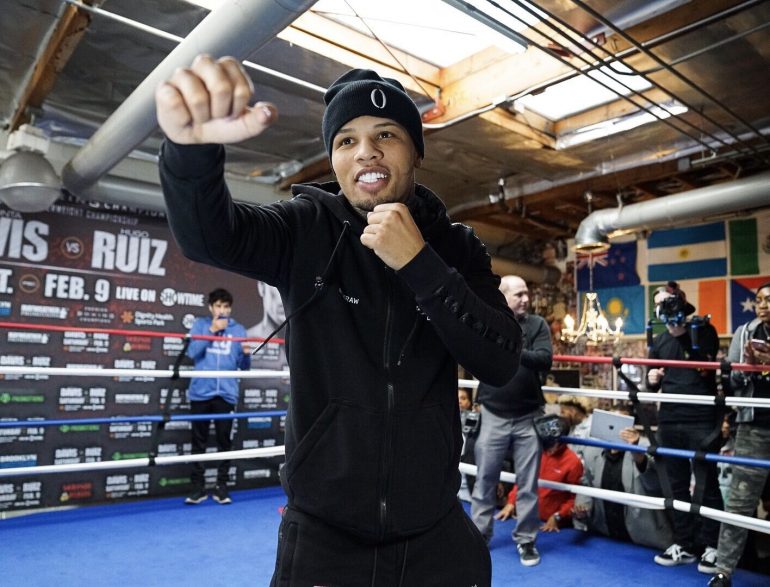
Please click here to read Part One.
Saturday, February 9 (continued): Entering the ring to the strains of Michael Jackson’s “Thriller” – the title song of an album whose November 30, 1982 release pre-dated his birth by nearly 12 years – Gervonta Davis delivered on the hype by stopping late substitute Hugo Ruiz at 2:59 of the first round.
A right hook to the jaw – along with the pain of a broken nose – prompted Ruiz to fall to all fours, and, upon rising, he failed to respond sufficiently to referee Jack Reiss’ questioning. Instead of promptly answering in the affirmative, Ruiz said nothing.
“Ruiz didn’t answer me,” Reiss told Showtime’s Jim Gray. “I told him clearly, in the dressing room, what he needed to do. When I asked him in Spanish if he wanted to continue, he didn’t answer. He was really hurt. He basically made the decision. If he just [nodded his head], we would have kept going.”
By ending the fight in round one, the thicker and stronger Davis did to Ruiz what Ruiz had done to 18 previous opponents while also recording his own first-round stoppage for the eighth time. The raw CompuBox numbers, while small, nevertheless illustrated the degree of Davis’ dominance. He threw nearly three times as many punches (56 to 19), connected on three times as many power punches (9-3) while nearly quadrupling Ruiz’s total connects (11-3), and produced a 50%-19% gap in power accuracy. Of Davis’ nine landed power punches, four were to the body. Conversely, Ruiz landed just three punches in the entire fight.
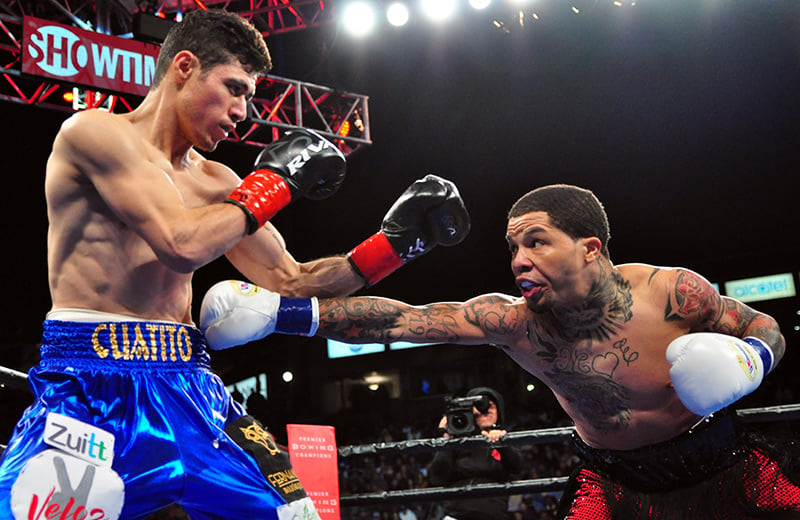
Gervonta Davis (right) stabs Hugo Ruiz to the body with a hard jab. Photo by German Villasenor
“Tonight, I just wanted to put on a great performance,” Davis told Gray. “I was scheduled to fight Abner Mares, but he had an injury (a detached retina that has now been surgically repaired). So, my main goal tonight was to make a great performance, which I did.”
During a week in which WBC titlist Miguel Berchelt withdrew from a March 23 rematch with Francisco Vargas due to a hand injury and during a night in which WBA “world” titlist Alberto Machado was stunningly stopped by Andrew Cancio in four rounds, Davis, who raised his record to 21-0 (20), can make a strong argument that he is the best super featherweight boxer on the earth at this moment. IBF counterpart Tevin Farmer, the division’s best pure boxer, can make a solid argument while Berchelt has been nothing but impressive since winning his belt from Vargas two years ago. Meanwhile, the WBO’s Masayuki Ito built on his upset win over Christopher Diaz with a seventh round TKO over previously undefeated challenger Evgeny Chuprakov December 30 in Tokyo. But, with his second consecutive demolition following his sour but victorious stoppage of Francisco Fonseca on the Mayweather-McGregor undercard in August 2017, Davis is offering convincing evidence that this is the “Tank” we’ll be seeing for some time to come. Better yet, Davis, who fought just once in 2018 and was coming off a career-long 10-month layoff, promised to be seen much more often in 2019.
“I’m very confident that I will be more active this year,” Davis said. “I have three, probably four fights lined up this year. I’m happy with my team and ready for the next.” That “next” could be a homecoming fight in Baltimore in July.
One powerful stumbling block that may keep Davis from assembling an extensive reign at 130 is weight. At 24, Davis remains the sport’s youngest American-born champion, and given the fact he had to step on the scale a second time at the weigh-in, he may not be long for this weight class. Like his friend Adrien Broner, Davis has been overpowering at 130 and probably will be a force at 135. But, given his stocky physique and modest height (5-foot-5 ½ inches) and reach (67 ½ inches) – traits he shares with Broner — his ceiling might be 140.
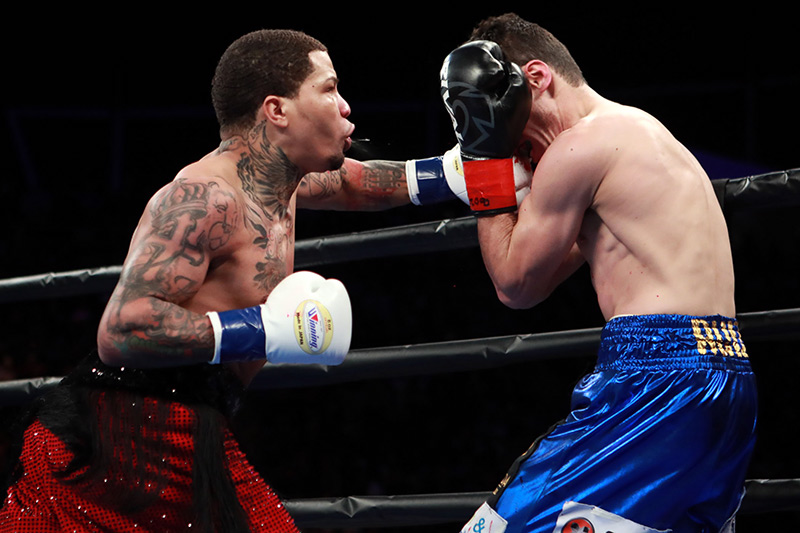
Gervonta Davis (left) on the attack vs. Hugo Ruiz. Photo by Dave Mandel-SHOWTIME
As for Ruiz, he must be given full credit for accepting this challenge just three weeks after winning a 10-round decision over Albert Guevara on the Manny Pacquiao-Adrien Broner card, which was aired on Showtime’s pay-per-view arm. While he owned sufficient height and reach advantages (four inches and three inches respectively), the former WBC titlist at super bantamweight lacked the physical strength to keep this “Tank” at bay.
“He’s very strong,” Ruiz said. “His hands were very heavy form the start. He looked like he put on a lot of weight from the time of the weigh-in (he was right; according to the pre-fight graphic Davis added 12 pounds). Every punch he landed hurt. I think he broke my nose.”
Ruiz may be criticized in some quarters for his failure to answer Reiss, and it is unknown whether he knew the round’s end was so close at hand. Even if he did, he had to know his fate was all but sealed the moment Davis broke his nose. Fighting Davis while healthy is a formidable enough task, but the prospect of fighting him for another 11-plus rounds with such an injury was more than Ruiz was willing to accept. Because that prospect would be more than most other people would be willing to accept, I don’t see Ruiz’s decision as an act of cowardice; I see it as an act of pragmatism.
*
Mario Barrios is listed as the WBA’s number-one contender for Kiryl Relikh’s “super” title, and in destroying the ultra-tough Richard Zamora in four rounds he looked every inch the top contender. The 5-foot-11 Barrios towered over the 5-foot-8 ½ Zamora, and, at 158 ½ inside the ring, he had a working 6 3/4-pound advantage. Though the picture on the pre-fight graphic saw Barrios with a darkened area under his right eye, his face was blemish-free inside the ropes, which tells me the mark was not a bruise but rather a result of his weight-reducing regimen.
Once the bell sounded, Barrios emphatically proved his superiority by pumping in stiff, snappy jabs, then, starting in round two, mixing in power counters and combinations that landed with frequency and flushness. But every time Barrios connected with his bombs, Zamora defiantly absorbed their impact, then did his best to answer. His best answer came with 66 seconds left in the third when he blasted a big right off Barrios’ jaw, but the larger Barrios immediately shook off the blow and continued to tend to business.

Junior welterweights Mario Barrios (right) and Richard Zamora throw down in their fight, which Barrios won by 4th round KO. Photo by Dave Mandel/SHOWTIME
That business picked up considerably in round four as he drove Zamora back with a right hand, threw Zamora to the canvas, blasted hard to the body, maneuvered his quarry to the corner pad and launched an extended assault. But even as Barrios drove hard for the TKO win, Zamora lashed out with desperate swings that mostly missed the mark but confirmed his innate competitiveness. That competitiveness only spurred Barrios to step up his attack even more, and moments after a monstrous cross connected and a flurry of blows caused Zamora to dip his upper body, referee Ray Corona intervened.
The numbers backed up Corona’s move. In round four alone, Barrios out-threw Zamora 97-31, out-landed him 43-6 overall and 37-4 power, and connected on 64% of his hooks, crosses and uppercuts. His final leads were 106-27 overall, 29-13 jabs, 77-14 power and 30-8 in body connects while his percentage gaps were equally emphatic (38%-20% overall, 59%-22% power).
“It was amazing, man,” Barrios told Gray. “I tip my hat to Zamora, he’s a hell of a warrior. All my respect to him and I wish him nothing but the best for the remainder of his career. Like he said at the press conference, he wanted a war, I brought it to him and total respect to Zamora.”
Blow-by-blow man Mauro Ranallo called for a repeat TV appearance for Zamora, and I agree. Analyst Al Bernstein recommended a fight against a top-15 fighter to further sharpen his defensive skills, and I agree. But if Team Barrios decides to assert his mandatory status and fight Relikh, I believe his size, power and combination punching could result in a title change.
*
Most of the first five rounds of Fortuna-Bogere was as cold and tepid as the weather as they hunted and pecked for openings and prompted the shivering crowd to emit boos from time to time. While Bogere did his best to push the fight with his volume (53.8 per round to Fortuna’s 30.2) and his excellent jabbing (28 attempts per round and a 22-10 connect lead, including 15 to the body), Fortuna’s hard-to-decipher southpaw style and his historically wayward head didn’t make things easy. Through five rounds, Bogere led 48-32 overall and 26-22 power, but Fortuna’s accuracy leads of 21%-18% overall and 26%-20% power gave him reason to hope for a turnaround.
That hope came true in the opening moments of round six, when both men suddenly upped the work rate and exponentially increased the intensity. Fortuna seemed more at home with the wild and crazy action and he soon produced results as a hard-to-see left uppercut and a push-down scored the fight’s only knockdown in the sixth while accidental butts opened a cut over Fortuna’s right eye in the sixth and a worse gash over Bogere’s right orb in the seventh. But in terms of tactics, Fortuna turned the fight by turning his attention to Bogere’s body; in the first five rounds Fortuna trailed 27-15 in body connects but in rounds 6-10 he prevailed 49-26 (including 30-9 in rounds 8-10) to extend his final lead to 61-41.
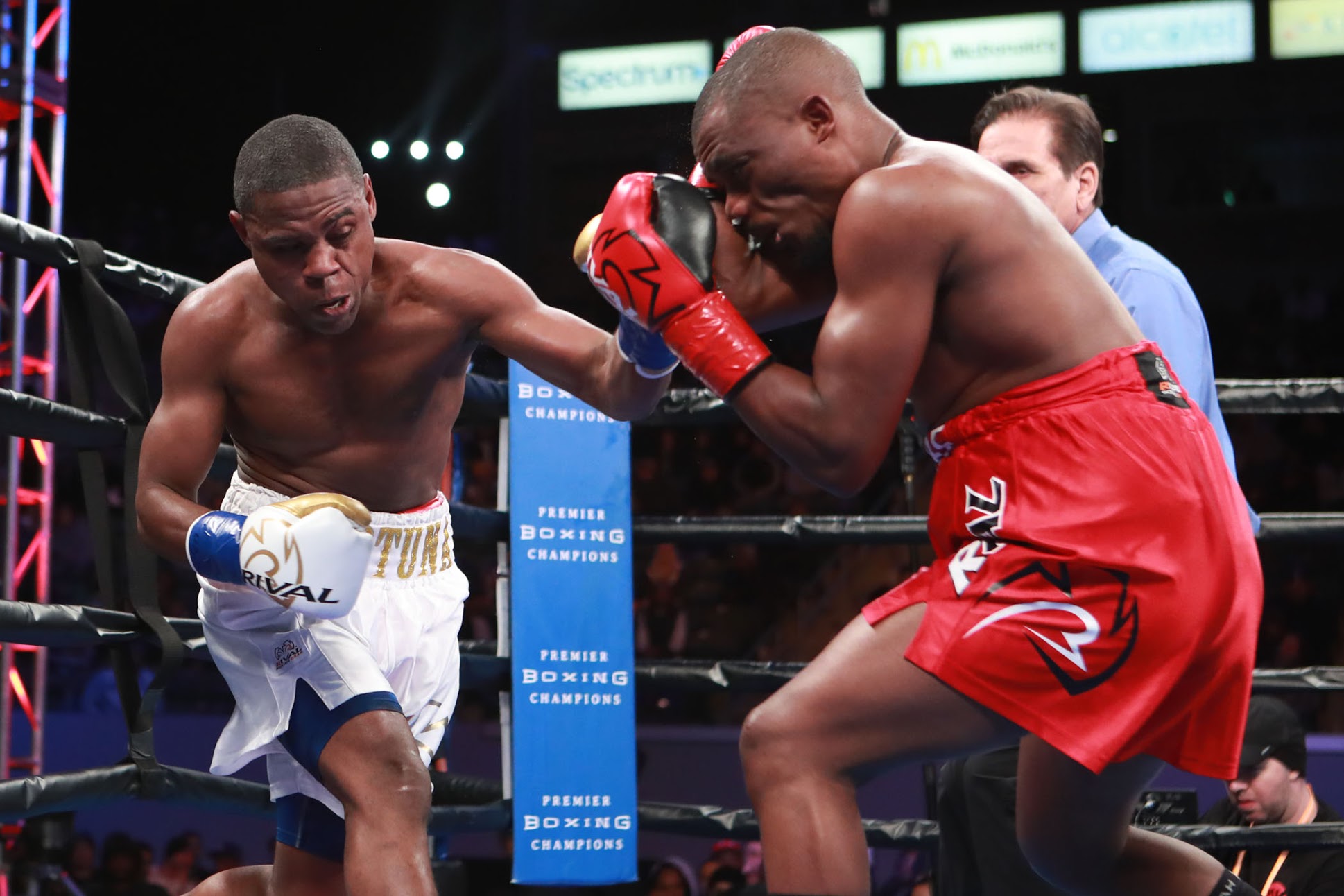
Lightweight Javier Fortuna (left) vs. Sharif Bogere. Photo by Dave Mandel/SHOWTIME
In the final five rounds, Fortuna upped his work rate from 30.2 to 54 punches per round while Bogere lifted his output from 53.8 to 68.8, but Fortuna out-landed him 69-56 overall and 67-33 power to cut Bogere’s lead in total connects to 104-101 but take an 89-59 lead in landed power punches. The CompuBox round-by-round breakdown of total connects – useful because clean punching is a primary area of attention for judges – had each man winning five rounds, but, because of the sixth-round knockdown, it was nearly in line with the 96-93 scores submitted by all three judges. Interestingly, as Showtime’s Steve Farhood pointed out, all three judges scored every round the same.
Fortuna said through translator Felix DeJesus that his trainer told him to pick up the pace in round six when they spotted Bogere’s ebbing energy, and the body attack effectively exacerbated the Ugandan’s issues. When asked about a rematch with Robert Easter, Fortuna, recognizing that such a bout wouldn’t draw sufficient money and wouldn’t involve a title, instead called out Lomachenko and Davis. He may want them, and while Davis and Lomachenko would rightly be deemed heavy favorites to win, would they want to deal with the “Bumblebee’s” peculiar brand of fighting before they absolutely have to do so? For this reason, I think that Fortuna will need to secure mandatory status first.
*
Dennis and I, along with his wife Jennifer, departed ringside, and, instead of consuming whatever post-card food was available to the Showtime crew, we caught the final minutes of the other pro sporting event taking place at the venue, a pre-season MLS match between Toronto and the homestanding Galaxy. The Galaxy led 1-0 thanks to a deflected ball off Toronto’s Terique Mohammed in the 55th minute but Toronto produced the equalizer in the 87th minute in equal fashion – a deflection off L.A.’s Dave Romney. I haven’t watched nearly as much soccer as I have most other sports, but I know that a 1-1 game resulting from a pair of own-goals must be highly unusual.
Knowing the end of the game would swell the already formidable exiting crowd (and their vehicles), we decided to depart at that point. As we made the long walk toward Dennis’ rental car – a stylish Ford Mustang – we noticed that the chill we felt at ringside had virtually vanished. It felt more than the mid-50s temperature claimed on the weather websites. During the fights, we felt as if the mercury was in the upper 40s, with the occasional gust making it feel even colder. Although the cold made it difficult to write notes to the talent and to type the recaps for the CompuBox files I e-mailed to the Showtime PR team, my ability to record punches was unaffected.
Once Dennis got past the scrum of cars at the venue, his drive back to the hotel was completed with dispatch. After purchasing a snack at the lobby’s mini-mart, I returned to the room to enter the night’s data into the master database. Between completing that task, consuming my food and drink and engaging in the usual winding-down process, I didn’t turn out the light until 1:30 a.m.
Sunday, February 10: I only got three hours of occasional rest, but after completing the morning routines I was back to my alert self. I checked out of the room and settled the bill at 5:30, and, as told to me by a hotel staffer the previous day, the taxi ride to LAX took just 20 minutes (“traffic is lightest on Sunday morning because that’s the one night of the week people here actually sleep in”).
I have long said that having TSA Pre-Check is a godsend, and a big reason why was illustrated this morning at LAX. Even at this time of morning, the line at the conventional security area stretched into the hundreds while the TSA Pre-Check area was so light that I walked up to the counter less than 60 seconds after arriving. My five-year certification will run out this summer, and I will re-up at the first opportunity.
I drew a good place in line for the LAX-to-PIT leg (B-4), so there was no need to upgrade. Because I wanted a window seat, however, I ended up in row 21 of the 24-row plane. The cross-country ride was occasionally bumpy, but, thanks to a healthy tailwind, the flight lasted less than four hours. When I walked to my car, the skies were merely gray and the temperature in the mid-30s, but all that changed shortly after beginning my drive home.
It started as scattered flurries, then slowly intensified with every southward mile. By the time I crossed into Ohio 90 minutes into my drive, the snow had covered significant parts of the highway and forced me to slow down to 45 mph. The worst of it, however, happened when I turned onto Friendly Hill, which asks drivers to complete two hairpin turns in just the first half-mile. The second such turn proved impossible for a driver ahead of me as the slippery conditions caused his driver’s side tire to spin. Thankfully, emergency personnel was in the area – a wreck occurred just outside Friendly on West Virginia Route 2 – and he was eventually pulled up the hill and to safety.
Meanwhile, my 150-foot angled driveway had a half-inch of snow covering it, which, in the past, proved problematic if I didn’t get a proper run on it. Though I felt the wheels spin a bit, I had enough traction to get to the top, officially ending my drive nearly three hours after starting it.
My winter wars will continue at least one more week, for I will be traveling to a new city in Mulverne, Kansas for a “ShoBox: The New Generation” doubleheader pitting super bantamweights Jesse Angel Hernandez and Thomas Patrick Ward, and, in the main event, super lightweights Shohjahon Ergashev and Mykal Fox.
Until then, happy trails!
*
Lee Groves is a boxing writer and historian based in Friendly, West Virginia. He is a full member of the BWAA, from which he has won 16 writing awards, including two first-place awards, since 2011. He has been an elector for the International Boxing Hall of Fame since 2001 and is also a writer, researcher and punch-counter for CompuBox, Inc. He is the author of “Tales from the Vault: A Celebration of 100 Boxing Closet Classics” (available on Amazon) and the co-author of the newly released book “Muhammad Ali: By the Numbers” (also available on Amazon). To contact Groves about a personalized autographed copy, use the email [email protected] or send him a message via Facebook.
Struggling to locate a copy of The Ring Magazine? Try here or
Subscribe
You can order the current issue, which is on newsstands, or back issues from our subscribe page.


